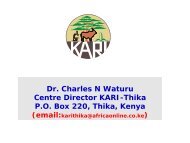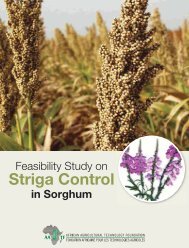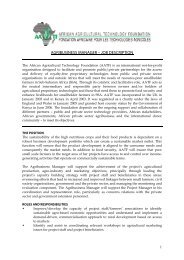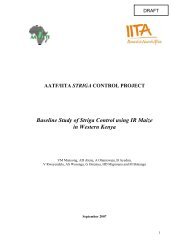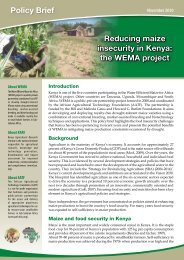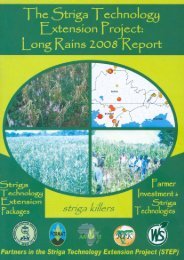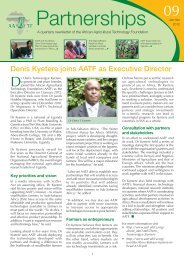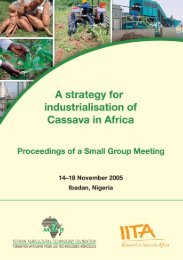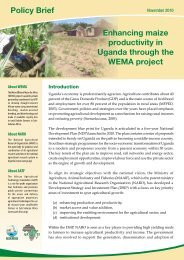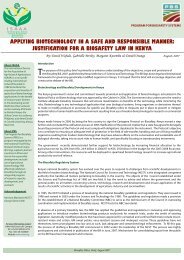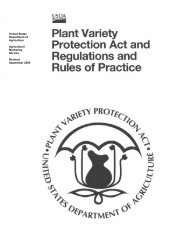Experiences in sub-Saharan Africa with GM crop risk communication
Experiences in sub-Saharan Africa with GM crop risk communication
Experiences in sub-Saharan Africa with GM crop risk communication
You also want an ePaper? Increase the reach of your titles
YUMPU automatically turns print PDFs into web optimized ePapers that Google loves.
the various tools employed periodically assessed. Biotechnology<br />
awareness discussions should be organized <strong>in</strong> collaboration <strong>with</strong><br />
agricultural extension services, and biotechnology education<br />
should be directed not only towards adults but also to the endusers<br />
of tomorrow. As such, relevant topics should be <strong>in</strong>cluded <strong>in</strong><br />
school curricula and/or <strong>in</strong>teractive programs <strong>with</strong> a biotechnological<br />
theme should be organized.<br />
Pool<strong>in</strong>g resources and collaboration at the regional level can<br />
also make a big difference. The possibility of work<strong>in</strong>g <strong>with</strong><br />
regional bodies [e.g. the Common Market for Eastern and<br />
Southern <strong>Africa</strong> (COMESA), the Economic Community of<br />
Central <strong>Africa</strong>n States (ECCAS), the Economic Community<br />
of West <strong>Africa</strong>n States (ECOWAS), etc.] was discussed by the<br />
participants at the workshop, but the conclusion was that a<br />
system <strong>in</strong> which <strong>in</strong>dividual <strong>communication</strong> programs coalesce<br />
around a bigger <strong>communication</strong>s plan would be more practical,<br />
due to political reasons. Yet, there is a great potential for countries<br />
<strong>in</strong> SSA to learn from one another <strong>in</strong> terms of biosafety<br />
data, <strong>in</strong>itiatives, tools and <strong>in</strong>teractions <strong>with</strong> stakeholders. On<br />
the question of how best a project to enhance <strong>risk</strong> <strong>communication</strong><br />
<strong>in</strong> <strong>Africa</strong> would proceed, it was reported dur<strong>in</strong>g workshop<br />
discussions that a similar attempt had been made by <strong>Africa</strong>Bio<br />
(www.africabio.com), whereby a needs assessment and stakeholders<br />
consultation was carried out and <strong>in</strong>terventions for<br />
implementation were designed. The latter <strong>in</strong>cluded: us<strong>in</strong>g<br />
workshops to develop key tools, develop<strong>in</strong>g messages, such as<br />
frequently asked questions (FAQs) and newsletters, build<strong>in</strong>g<br />
the personal capacity of communicators and regulators, develop<strong>in</strong>g<br />
<strong>communication</strong> networks, address<strong>in</strong>g knowledge gaps,<br />
build<strong>in</strong>g a critical mass of scientists to spearhead <strong>communication</strong><br />
networks and identify<strong>in</strong>g ways to build media resources<br />
through journalist tra<strong>in</strong><strong>in</strong>g. As an immediate workshop outcome,<br />
an <strong>in</strong>formation-shar<strong>in</strong>g platform to enable access to<br />
<strong>in</strong>formation and, hence, promote <strong>in</strong>formed decision-mak<strong>in</strong>g<br />
was proposed.<br />
In circumstances where cooperation proves difficult, a more<br />
<strong>in</strong>formal network for <strong>in</strong>formation exchange composed of <strong>risk</strong><br />
<strong>communication</strong> practitioners should be created, beg<strong>in</strong>n<strong>in</strong>g<br />
<strong>with</strong> the participants of the workshop. Together, a web page,<br />
on-l<strong>in</strong>e discussions and conferences could facilitate the development<br />
of the network, while not requir<strong>in</strong>g extensive fund<strong>in</strong>g.<br />
However, meet<strong>in</strong>gs such as workshops and conferences <strong>with</strong> specific<br />
foci should be organized periodically. Examples of topics<br />
<strong>in</strong>clude “Language <strong>in</strong> <strong>risk</strong> <strong>communication</strong>,” “Communication<br />
tools,” “Tra<strong>in</strong><strong>in</strong>g of journalists for biotechnology report<strong>in</strong>g,”<br />
“Community <strong>in</strong>volvement <strong>in</strong> <strong>risk</strong> <strong>communication</strong>” and<br />
“Improv<strong>in</strong>g <strong>communication</strong> amongst stakeholders.” In addition,<br />
regional <strong>communication</strong> networks should be created to facilitate<br />
<strong>in</strong>formation exchange amongst same-level experts, such as agricultural<br />
scientists, science journalists, <strong>GM</strong> <strong>crop</strong> R&D scientists,<br />
etc. Such networks would not necessarily need to be built from<br />
scratch but could <strong>in</strong>stead be built <strong>with</strong><strong>in</strong> exist<strong>in</strong>g wider frameworks.<br />
Support<strong>in</strong>g funds may be available from <strong>in</strong>ternational<br />
organizations or via partnerships amongst public-private <strong>in</strong>stitutions<br />
<strong>with</strong><strong>in</strong> SSA.<br />
Acknowledgments<br />
The authors are <strong>in</strong>debted to the participants of a biosafety <strong>risk</strong><br />
<strong>communication</strong> workshop, organized by the ICGEB <strong>in</strong> collaboration<br />
<strong>with</strong> the University of Mauritius and the Food and<br />
Agricultural Research Council (FARC), which was held 8-10 June<br />
2011, <strong>in</strong> Quatre Bornes, Mauritius. The participants shared freely<br />
of their <strong>in</strong>formation and experiences and <strong>in</strong>spired active discussions<br />
on the workshop topic. The authors would like to thank the<br />
follow<strong>in</strong>g <strong>in</strong>dividuals for their contributions to the workshop discussions:<br />
Umaru Abu, AATF, Nigeria; Rocks Sunday Igu Akile,<br />
National Council for Science and Technology; Ibrahim Atokple,<br />
CSIR-Savanna Agriculture Research Institute, Ghana; Yash<br />
Dharam Bachraz, FARC, Mauritius; Krishan Bheenick, F ARC,<br />
Mauritius; Kwabena Mante Bosompem, Noguchi Memorial<br />
Medical Research Institute, Ghana; Anita Burger, Biosafety<br />
South <strong>Africa</strong>, South <strong>Africa</strong>; Adama Compaore, Agence Nationale<br />
de Biosécurité, Burk<strong>in</strong>a Faso; Alidou Christophe Diebre,<br />
Observatoire National de Biosécurité, M<strong>in</strong>istere de la Defense<br />
Nationale, Burk<strong>in</strong>a Faso; Asha Dookun-Saumtally, Mauritius<br />
Sugar Industry Research Institute, Mauritius; Francesca Farolfi,<br />
Biosafety Unit, ICGEB, Trieste, Italy; Nitish Gopaul, M<strong>in</strong>istry<br />
of Agro-Industry and Food Security, Mauritius; Omer Hema,<br />
Institute of Environment and Agricultural Research, Burk<strong>in</strong>a<br />
Faso; Margaret Karembu, ISAAA AfriCenter work<strong>in</strong>g <strong>in</strong> partnership<br />
<strong>with</strong> the National Biosafety Authority, Kenya; Eucharia<br />
Kenya, AATF, Kenya; Madhu Shyam Beni, Agricultural Research<br />
& Extension Unit, Mauritius; Kefa Herbert Oloka, IFPRI,<br />
Uganda; Daneshwar Puchooa, National Biosafety Committee,<br />
Faculty of Agriculture, University of Mauritius, Mauritius;<br />
Soodevi Soobron, M<strong>in</strong>istry of Environment and Susta<strong>in</strong>able<br />
Development, Mauritius; Grace Wachoro, AATF, Kenya; and<br />
Stephen Zuke, Swaziland Environment Authority, Swaziland.<br />
In addition, the authors would like to thank workshop participant<br />
Lynn Frewer, Newcastle University, UK, for help<strong>in</strong>g shape<br />
and improve the quality of this manuscript <strong>in</strong> addition to her<br />
contribution to the workshop discussions. The workshop was<br />
carried out as part of a biosafety capacity-build<strong>in</strong>g project for<br />
<strong>sub</strong>-<strong>Saharan</strong> <strong>Africa</strong>, implemented by the ICGEB and funded by<br />
the Bill & Mel<strong>in</strong>da Gates Foundation. The f<strong>in</strong>d<strong>in</strong>gs and conclusions<br />
conta<strong>in</strong>ed <strong>with</strong><strong>in</strong> are those of the authors and do not necessarily<br />
reflect positions or policies of the Bill & Mel<strong>in</strong>da Gates<br />
Foundation nor the ICGEB.<br />
8 <strong>GM</strong> Crops and Food: Biotechnology <strong>in</strong> Agriculture and the Food Cha<strong>in</strong> Volume 4 Issue 1



